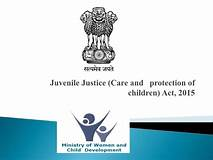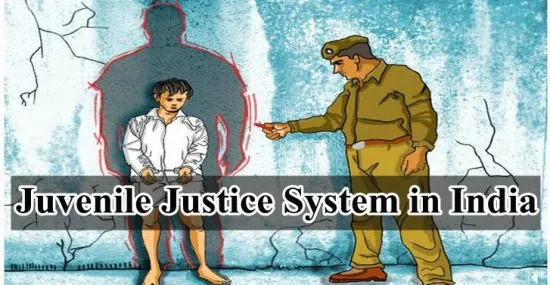JUVENILE JUSTICE ACT: The object AND achieveMENT
The Juvenile Justice Act was comprehensively
enacted in the name of The Juvenile Justice (Care and Protection of Children)
Act 2015 and periodically the provisions were amended with a view to reach out
to the victim in effective way. The constitution, more particularly, Article
15(3) and Article 39 clause (e) & (f) as well as Article 45 and Article 47
contains power and stipulates duties on the authorities in this regard. It is
emphasized therein that basic needs of children are met and the rights of
children are protected. The same is also in sync with article 21 of
Constitution of India relating to Right to Life and Personal Liberty. What is
required to be noted further is that Juvenile Justice (Care and Protection of
Children) Act, 2000 was enacted earlier, but it was felt that a comprehensive
provisions are required. In the backdrop of standards prescribed in the
convention on the Rights of the Child and the United Nation Rules for the
Protection of Children and Co-operation in respect of Inter country Adoption
(1993) and such other International Instruments.
Though the object as set out
under the Act is laudable, still, the same has been achieved only partially.
The India is a nation of youth and the children. The children, being the
precursor of youth are also in vast numbers. The age group of children and
adolescents shall inevitably be the backbone of tomorrow and therefore,
adequate emphasis is required to ensure their welfare and gradual progression
to maturity in a better environment, if not in an ideal environment. The vast
majority of children who are in slums and are not blesses with prosperity are
often victim of circumstances. No doubt, the welfare schemes existed and government
of the days have worked hard for catering to this segment and law and
legislation have also been enacted. However, the moot question shall be : is it
adequate? Or how much is too much?
The provision of existing law and
amendments in Juvenile Justice Act in the backdrop of above shall be anaylyzed.
Unfortunately, the children are perceived as a commodity for sale despite the
law and welfare measures in favour of the children.
There is no denying that despite
the progress made by the nation, since independence, the lot of children have
not improved substantially.
The existing Act of 2015 is sought to
be amended yet again and The Juvenile Justice (Care and Protection of Children)
Amendment Bill, 2021 was introduced in Lok Sabha on March 15, 2021 and is also
stated to have been passed from Rajya Sabha. The Bill amends the Juvenile
Justice (Care and Protection of Children) Act, 2015. The Statement
of Objects and Reasons of the 2021 Bill inter
alia states that adoption cases have witnessed significant delay in courts.
Further, it states that adoption cases are non-adversarial in nature and
can be dealt through a well laid out process.
THE PRELUDE TO JUVENILE JUSTICE
ACT 2015
The Law Commission of India have
made recommendation in 1993 inter alia seeking
prohibition of sale of children and various high courts of India has emphasized
the need for implementing the recommendation of Law Commission. However, there
was no much headway in this regard for quite some time. The Juvenile Justice
(Care & Protection of Children) Act 2000 was earlier enacted, but it was felt
that with a view to give fillip to the prevailing situation, a comprehensive
legislation prescribing various measures shall be necessary. The bill seeks to laid
down a proscription to the prevailing situation. The Juvenile Justice (Care
& Protection of Children) Act 2015 was enacted for catering to the
prevailing situation, still, the amendment was felt necessary and therefore the
2021 Bill seeks to achieve that. The proposed amendment through 2021 Bill has however
introduced some feature, which may not have helped the cause.
In any case, the Juvenile Justice (Care
& Protection of Children) Act 2015 is amended and the same are likely to be
notified as about to be notified as The Juvenile
Justice (Care & Protection of Children) Act 2021. A “juvenile” as per the Act is a person less than 18 years
of age. We also know that the Juvenile Justice (Care and Protection of
Children) Act, 2015 addresses children in conflict with law and children in
need of care and protection. India is a signatory to the United
Nations Convention on the Rights of the Child, at Hague Convention on
Protection of Children and Co-operation in respect of Inter-country Adoption in
1993 and it is only natural that the Act may be seen as India's commitment to
child rights. The India is obligated to initiate and take all appropriate
measures to ensure the rights of children with regard to juvenile justice, care
and protection, and adoption.
The offence against the children
is defined and offences are made cognizable. As per Sec6tion 154 of the
Criminal Procedure Code, the police is mandated to register F.I.R, if a
cognizable offence is disclosed and investigation shall be the necessary
corollary to that. Though, since then, progress is made but the contemplated
amendment could well turn out that progressing by making one forward step may
be hit and that may be akin to take a step back. The cognizable offences are
investigated by the police and that is the mandate in law, however, the
proposed amendment seeks to suggest that the offences hitherto, cognizable
shall be non cognizable. Therefore, in the event complaint is reported, the
victim is to approach courts of law i.e courts of Metropolitan Magistrate or
Judicial Magistrate, as the case may be,
u/s 156(3) of Cr.P.C for seeking registration of F.I.R. What could have
been achieved as a matter of course, shall now be subject to the orders passed
by Magistrate. The courts in any case are overburdened with their respective
roster and if such a case is also to flow on them, the delay shall be
inevitable. Moreover, many children , their parents or organization supporting
them may not be as resourceful and therefore, the proposed amendment needs a
fresh look. The Juvenile Justice (Care & Protection of Children) Amendment
Act 2021 deserves a relook. No doubt, there are also provision of free legal
aid, but many does not have the wherewithal to approach for the legal aid. That
apart, the delay owing to the pre-requisites of a direction from a courts of
Magistrate may inevitably delay the process.
INFRASTRUCTURE
and Lack of availability and limited capacity of institutions
The infrastructure and institutions set up under the Act are far from
adequate. The 2015 Act provides for setting up one or more Juvenile Justice
Boards (JJBs) and Child Welfare Committees (CWCs) in every district. The
Standing Committee on Human Resource Development (2015) had noted that
statutory bodies under the Juvenile Justice Act, 2000 including JJBs
and CWCs were not present in many states. Moreover, several bodies existed
only on paper, and were not functioning. Further, populous districts
which were likely to produce larger caseloads had inadequate CWCs.
The National Legal Services Authority
(2019) noted that only 17 of 35 states/Union Territories (UTs) had all basic
structures and bodies required under the Act in place For example, states such
as Assam, Bihar, and Haryana, did not have CWCs in all districts. The
Standing Committee on Human Resource Development (2015) also noted that CWCs
and JJBs lack authority to manage their financial and human resources and
are dependent on the state or district administration. Due to lack of
infrastructure or specific funds, action taken by them was limited and
delayed. It recommended greater financial allocation, training and
cadre-building for various bodies.
Child-care
institutions (CCIs):
CCIs refer to institutions including
open shelters and specialised adoption agencies, which provide care and
protection to children in need of such services. As of March 2020, there
were 2,162 CCIs across India. The Committee on review exercise of CCIs (2018)
noted that many CCIs fail to provide even the basic amenities or services to
the children including individual bedding, proper nutrition and diet. The
hon’ble Supreme Court has recently recommended that state governments should evaluate
CCIs across India to ensure that minimum standards of care are being complied
with. The Committee also noted that despite registration being mandatory
under the 2015 Act, only 32% of total CCIs across the country were
registered. Though the Supreme Court has already recommended that all
children in CCIs be registered compulsorily and the same be verified and
validated.
Role of
High Courts:
The Supreme Court has also requested
the Chief Justice of every High Court to register proceedings on its own motion
to ensure effective implementation of the Act. It was also suggested that
Juvenile Justice Committees should be set up in every district and should
comprise of High Court judges, who have a constitutional obligation to protect
the fundamental rights of children.
The features of proposed amendment may
be anlysed hereinafter:
ISSUE
OF ADOPTION & DELAY
The 2015 Act empowered Central
Adoption Resource Authority (CARA) to regulate and promote adoptions in
India. In 2017, the Madhya Pradesh High Court noted that children
declared legally free for adoption were not being given timely referrals by
CARA. The Court recommended that the Steering Committee of CARA may
monitor and investigate the conduct of CARA. Further, action must be
taken against individuals responsible for the delay.
The Juvenile Justice (Care
and Protection of Children) Act, 2015 states that adoption of a child
is final on the issuance of an adoption order by the civil court. The 2021
Bill, however, provides that instead of the court, the District Magistrate
(including Additional District Magistrate) will issue such adoption orders. The
issue of adoption and its requisites entails law and the same has to stand
judicial scrutiny and therefore delegating the power to executive authority may
have inherent pitfalls. If the idea of early decision was the driving factor,
then the same is contrary to the proposal that offence under the Act shall be
non-cognizable and delay is inbuilt there and therefore expedition appears to
be not the object. The order of adoption
may also hit roadblock, given the nature and act being judicial and ought to be
passed by courts of law.
Under the Act, once prospective
adoptive parents accept a child, an adoption agency files an application in a
civil court to obtain the adoption order. The adoption order issued by
the court establishes that the child belongs to the adoptive parents. The
Bill provides that instead of the court, the District Magistrate (including Additional
District Magistrate) will perform these duties and issue all such orders.
Appeals: The Bill
provides that any person aggrieved by an adoption order passed by the District Magistrate
may file an appeal before the Divisional Commissioner, within 30 days of such
order. Such appeals should be disposed within four weeks from the date of
filing of the appeal.
The Act provides that there will be no
appeal for any order made by a Child Welfare Committee concluding that a person
is not a child in need of care and protection. The Bill removes this
provision.
Incidence of crime:
Under the Indian Penal Code, 1860
(IPC), the minimum age at which any person can be charged for a crime is seven
years.
The total number of children arrested year wise has shown a trend of significant
increase in number. The Children in the 16-18 years’ age group account for
majority of children arrested. More than half of the children were arrested
for offences such as theft, causing hurt, burglary, and riots.
Under the 2015 Act offences committed by juveniles are categorised as heinous offences, serious offences, and petty offences. Serious offences include offences with Three (3) to Seven (7) years of imprisonment. The present Bill adds that serious offences will also include offences for which maximum punishment is imprisonment of more than seven years, and minimum punishment is not prescribed or is less than seven years.
Serious offences: The
Act provides that the Juvenile Justice Board will inquire about a child who is
accused of a serious offence. Serious offences are those for which the
punishment is imprisonment between three to seven years. The Bill adds
that serious offences will also include offences for which maximum punishment
is imprisonment of more than seven years, and minimum punishment is not
prescribed or is less than seven years.
Designated Court: The Act has designated
court for trying juvenile cases.
The Act, hitherto, provided that
offences against children that are punishable with imprisonment of more than
seven years, will be tried in the Children’s Court (equivalent to a Sessions
Court). Other offences (punishable with imprisonment of less than seven
years) will be tried by a Judicial Magistrate. The Bill amends this to
provide that all offences under the Act will be tried in the Children’s Court.
Offences against children:
The Act earlier provided that an
offence under the Act, which is punishable with imprisonment between three to
seven years will be cognizable (where arrest is allowed without warrant) and
non-bailable. The present Bill, however, now provides that such offences
will be non-cognizable and non-bailable.
Child Welfare Committees (CWCs):
The Act provides that states must
constitute one or more CWCs for each district for dealing with children in need
of care and protection. It provides certain criteria for the appointment
of members to CWC. For instance, a member should be:
(i)
involved in health, education, or
welfare of children for at least seven years, or
(ii)
a practicing professional with a
degree in child psychology, psychiatry, law, or social work.
The Bill adds certain criteria for a
person to be ineligible to be a member of the CWC. These include: (i)
having any record of violation of human rights or child rights, or (ii) being a
part of the management of a child care institution in a district.
The Juvenile Justice (Care and Protection of
Children) Act, 2015 states that adoption of a child is final once a civil court
issues an adoption order. The Bill seeks to amend this to provide for the District
Magistrate (including the Additional District Magistrate) to issue such
adoption orders instead. Any person aggrieved by such an adoption
order may file an appeal with the Divisional Commissioner.
Lack of judicial scrutiny in adoption
orders
Under the Act, adoption of a child is
final once a court issues an adoption order. With this, the child becomes
the lawful child of his adoptive parents with all the rights, privileges, and
responsibilities that are given to a biological child. The Bill shifts
the power to issue adoption orders from the court to the district magistrate
(including the additional district magistrate). The question is whether
it is appropriate for an administrative authority to issue adoption orders
instead of a judicial body.
The SOR of the Bill states that
adoption cases are non-adversarial in nature and can be dealt as per the
process laid out. Adoption of a child is a legal process which creates a
permanent legal relationship between the child and adoptive parents. When
deciding on adoption, courts review documents, ensure necessary procedures have
been complied with, and conduct an inquiry of the child and adoptive parents.
This helps ensure that due consideration is given to the wishes of the
child, and the adoption is for the welfare of the child. It may be argued
that determining whether the adoption is in the best interests of the child
requires judicial training and competence.
Further, the Bill provides that
any person aggrieved by an adoption order, may file an appeal before the Divisional
Commissioner. Thus, it does not provide for judicial overview even at the
appeal stage as well. District Magistrates and Divisional Commissioners
are trained to be administrators and perform functions of the government.
They may not have the competence to issue adoption orders or hear appeals
related to them. Vesting of such core judicial functions with them may
also raise concerns of separation of powers between the executive and the
judiciary.
Note that, since the Juvenile Justice
(Care and Protection of Children) Act, 2000 (replaced by the 2015 Act) came
into force, the power to issue adoption orders has rested with the courts. There
are several countries such as United Kingdom, Germany, France, and several
states in the United States of America, where adoption orders are issued only
by the court.
REMARK
From the broad canvas of above discussion
what may emerge is that the proposed amendments as per 2021 Bill which may be
notified in due course raises many questions that it seeks to answer. The fact
that the several offences against the Act is made non- cognizable could be
construed as a step back in as much as involving Magistracy for direction to
register F.I.R under the proposed amendment shall be cumbersome and adding to
the woes of overburdened Magistracy. Moreover, delay is inbuilt in it and hence,
the victim is likely to suffer. Apart from that, even if legal aid could be
made available to a child or victim, the fact remains that time shall be consumed
and the same may be wrangled into procedural complicacies. The issue of
adoption, on the other hand is a legal act and trained judicial prowess in pith
and substance shall be necessary. In this backdrop, according the power on
District Magistrate and even the Appellate Authority being an Executive body in
this regard may be counter- productive. The procedure that adoption entails and
the law is quite elaborate in this regard and therefore judicial pondering over
the issue is a must. The proposed amendments therefore seeks to relegate many
issue from the 2015 Act and the same are not desirable and should be done away
with.
Anil
K Khaware
Founder
& Senior Associate
Societylawandjustice.com










No comments:
Post a Comment